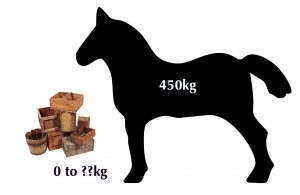Allowing for variations in care, diet and workload, a horse can be expected to live for 20 years. Starting work, a four-year-old has 16 years (80%) of its life ahead of it. For present purposes, we are going to need a notional unit for the work horses can carry out in a year, either as a species or individually. We need to correlate the mass of the animal to the mass of the load, using an average for the species or a more accurate set of measurements for an individual. Assuming that no horse will carry or haul a load greater than its own mass, we can use a percentage variable (load ratio) to represent the work output as a proportion of the mass of horses on the job.

There are two questions to answer at this stage. Firstly, given the aggregate mass of a specific horse population (horses on the job, a weight of n equine tonnes), how many tonnes of product (product tonnes) can be moved in a standard shift (equivalent to one working day)? Assuming an unlimited mountain of product/load to move, we multiply the equine tonnes by the load ratio (which will always be significantly less than 100%) to find a daily work load. The second stage is to turn a daily figure into an annual total, multiplying the daily work load by 365 (days) : let’s call it a “workhorse-year”
Developing a rough and ready measure of how much material a given number of horses can shift can also be inverted to give an idea of how many horses might be needed for a sector of the economy: dividing annual output by the relevant workhorse year. Whatever the sector, the answer is likely to be “too few horses”. The simple fact is that Britain was a net importer of horses for about 30 years, from the moment the Boer war battlefields saw the widespread use of machine guns. This is no coincidence, it is a simply a question of getting bullets into the air faster than the opposition. At about the same time, possibly earlier, the British army organised a Remount Scheme to supply officers with a replacement mount, should officers lose a horse.
Leave a Reply